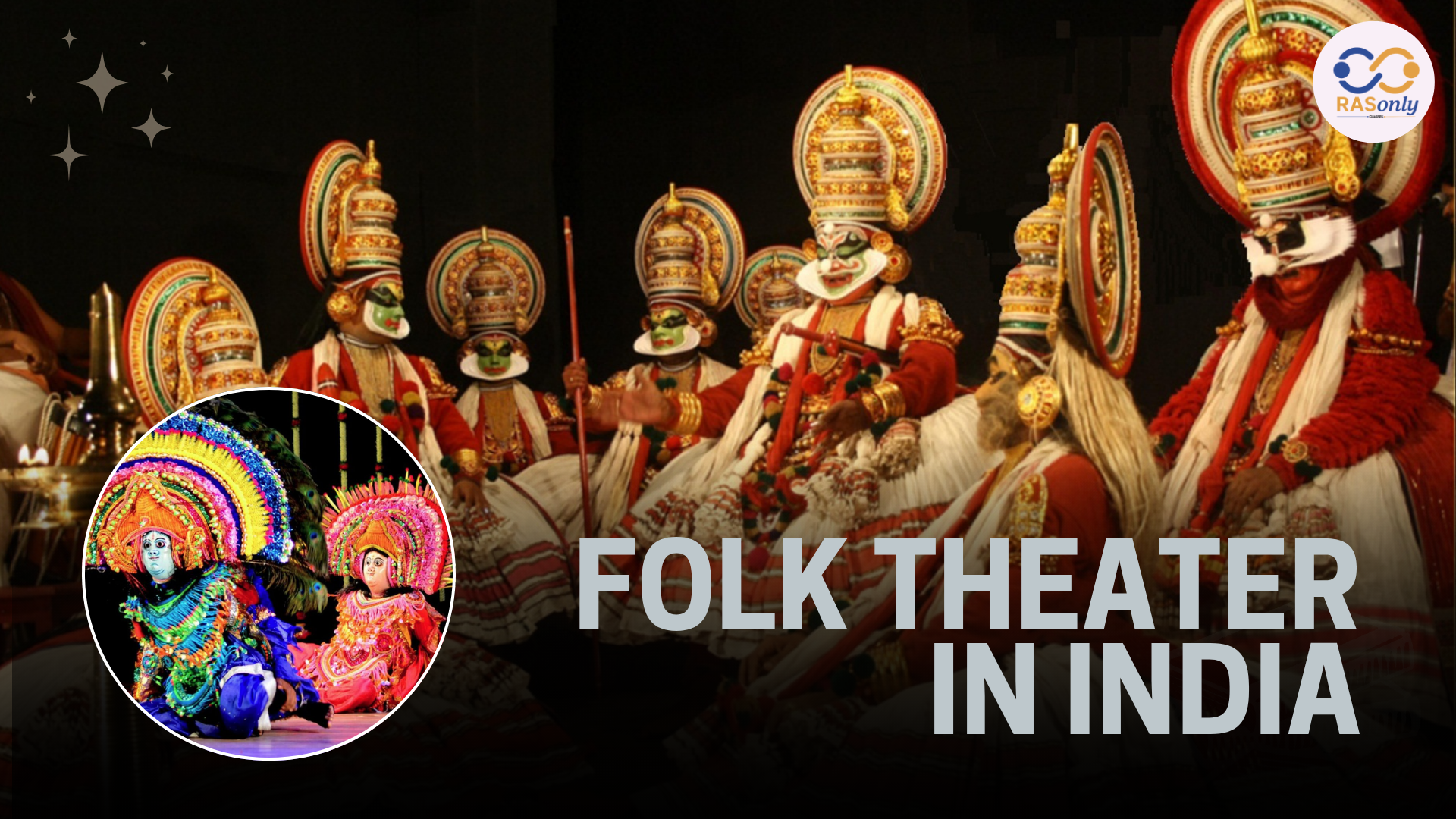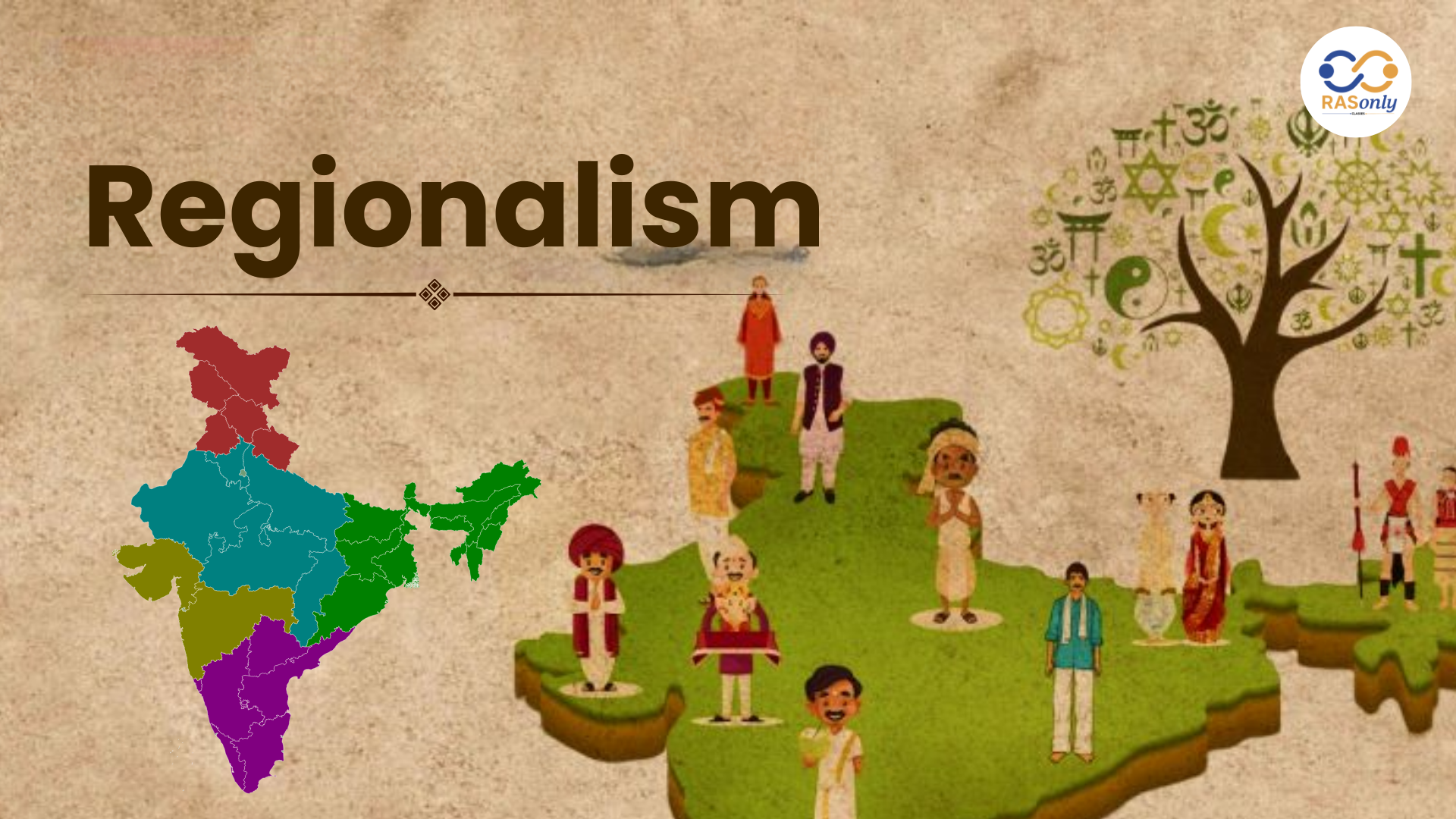Rajasthan Cooperative Societies (Amendment) Act, 2022
- >
- RAS Preparation Resources
- >
- Folk Theatre in India
Folk Theatre in India


Three Broad Classifications: Indian folk theatre is categorized into three broad classifications of Ritual Theatre, Entertainment Theatre, and South Indian Theatre. There are such performances as Ramlila, Ramman, and Bhuta Aradhana, which are associated with religious festivals, and national beliefs. Nautanki, Maach, Naqal, and Padayani, as market-popular entertainment styles, combine storytelling, music and humor to delight the masses in the countryside. The uniqueness of forms such as Bayalata, Tal-Maddale and Pagati Veshalu are characterized by the devotional story telling and dance-drama forms. These theatres maintain oral traditions, local dialects and folk history, which enhances cultural cohesion and identity on the grass root level.
Key Highlights for RAS Mains
Classification of Folk Theatre in India
|
Category |
Examples |
|
Ritual Theatre |
Ramlila, Ankia Naat, Ramman, Bhuta Aradhana |
|
Entertainment Theatre |
Nautanki, Maach, Naqal, Padayani |
|
South Indian Theatre |
Tal-Maddale, Bayalata, Pagati Veshalu |
Regional Art
- North India: Ramlila (U.P.), Nautanki (U.P., Haryana) Maach (Madhya Pradesh)
- East India: Bengal: Jatra, Kashmir: Bhand Pather
- South India: Yakshagana (Karnataka), Therukoothu (Tamil Nadu), Pagati Veshalu (Telangana)
- West India: Bhavai (Gujarat), Tamasha (Maharashtra), Swang (Haryana)
Folk Theater of states
|
Folk Theatre |
State/Region |
Description |
|
Bhand Pather |
Kashmir |
Satirical folk theatre using wit and parody; incorporates surnai, nagaara, and dhol; mostly performed by the farming community. |
|
Bhaona |
Assam |
Derived from Ankia Naat; begins in Sanskrit and transitions into Brajboli/Assamese; showcases culture from multiple regions. |
|
Bhavai |
Gujarat |
Predominant in Kutch and Kathiawar; mixes devotional and romantic elements. |
|
Burra Katha |
Andhra Pradesh |
Narration by one artist and two assistants; uses "Burra" drum; oral storytelling with chorus and rhythm. |
|
Chavittu Natakam |
Kerala |
Christian folk drama, also called stamping dance, originated in the 17th century. |
|
Dashavatar |
Konkan & Goa |
Enacts the ten incarnations of Vishnu; performers wear stylized masks and makeup. |
|
Daskathia |
Odisha |
Two narrators (Gayaka and Palia); tales of Shiva accompanied by wooden instruments 'Kathia'. |
|
Garodas |
Gujarat |
Art form of the Garoda community; storytelling using painted pictures about romance and bravery. |
|
Kariyila |
Himachal Pradesh |
Open-air night performances consisting of various skits and short plays. |
|
Kutiyattam |
Kerala |
Sanskrit-based classical theatre with defined roles; recognized as UNESCO Intangible Heritage. |
|
Krishnattam |
Kerala |
17th-century theatre sponsored by King Manavada consists of 8 Krishna-themed plays over 8 days. |
|
Kuruvanji |
Tamil Nadu |
Dance ballet in Bharatanatyam style; love-themed, first composed by Thirukutarajappa Kaviyar. |
|
Mudiyettu |
Kerala |
Ritual offering to Goddess Bhadrakali; performed in temples during Vrischikam (Nov–Dec). |
|
Oja-Pali |
Assam |
Celebrated during the Manasa festival; Oja is lead narrator, Pali is chorus; religious themes. |
|
Powada |
Maharashtra |
Ballads praising Shivaji’s heroism; sung by Gondhalis and Shahirs. |
|
Raasleela |
Uttar Pradesh |
Krishna-based narrative folk drama mixing prose and music; early plays attributed to Nand Das. |
|
Swang |
Punjab & Haryana |
Initially music-based; includes Haryanvi and Brajbhasha dialects; prose was later introduced. |
|
Tamasha |
Maharashtra |
High-energy performances; female lead (Murki) leads the dance; includes classical music and gestures. |
|
Therukoothu |
Tamil Nadu |
Draupadi-based stories; performed to invoke agricultural prosperity; includes a cycle of eight plays. |
|
Villu Pattu |
Deccan region |
Bow-song musical theatre format; focuses on Ramayana stories. |
|
Yakshagana |
Karnataka |
Open-air dance-drama portraying Mahabharata and Ramayana episodes; colorful costumes and music. |
Features
- Fusion of music, dancing and talking.
- Local dialects, costumes and symbolic props.
- Performed in open-air areas, or village squares.
- Involves social messages, mythology and satire.
Purpose and Significance
- Cultural Maintenance: Maintains traditions and oral tradition.
- Mass Education: the spread of knowledge and values with the help of entertainment.
- Community Bonding: Makes people more local and makes them participate together.
Conclusion
It is a living folk theatre which depicts cultural diversity, spirituality and storytelling traditions of India. And it is a social teacher and cultural keeper in the country and regions. To preserve India as a heritage of intangible assets, it is important to look after these art forms
RASOnly Interview Guidance Program

Mr. Ashok Jain
Ex-Chief Secretary Govt of Rajasthan
- IAS officer of the 1981 batch, Rajasthan cadre.
- Passionate about mentoring the next generation of RAS officers with real-world insights.
- Got retired in Dec 2017 from the post of Chief Secretary of the state of Rajasthan.

Mr. Guru Charan Rai
Ex-ASP / SP in Jaisalmer
- Guru Charan Rai, IPS (Retd), retired as Inspector General of Police (Security), Rajasthan, Jaipur in 2017.
- Served as ASP and SP in Jaisalmer, Nagaur, Sri Ganganagar, Sawai Madhopur, Dausa, Sikar, and Karauli.
- He also held key positions as DIGP and IGP in the Law and Order division.

Mr. Rakesh Verma
Ex-IAS Officer, B.Tech, MBA, and M.A. (Economics)
- IAS officer of the 1981 batch and retired in Chief Secretary Rank.
- Civil servant of high repute and vast experience.
- Has been teaching UPSC CSE subjects for the last six years.
👉🏻 Register Today to Join Classes! 👍🏻
- Team RASOnly -
🎯 Benefits of RASOnly Coaching:
- ✅ 1:1 Mentorship with RAS Officers
- ✅ Experienced and Expert Faculty
- ✅ Free Library Access
- ✅ Daily Minimum 4 Hours Must
- ✅ Comprehensive Study Material
- ✅ Regular Tests & Performance Analysis
- ✅ Personalized Guidance & Doubt Solving
- ✅ Online & Offline Class Options
- ✅ Affordable Fees with Quality Education
Key Highlights:
- 👉🏻 3-Day Refund Policy
- 👉🏻 New Batch Starting from 04 August
- 👉🏻 Registration Amount: Only ₹1000




